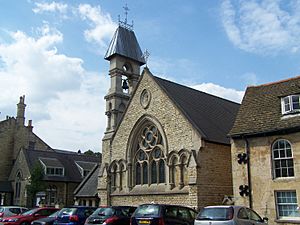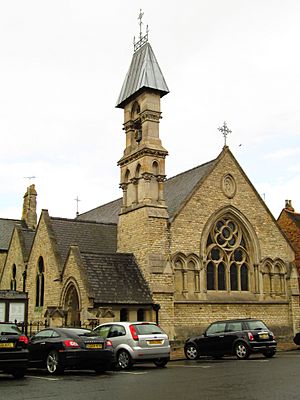Church of St Mary and St Augustine, Stamford facts for kids
The Parish Church of St Mary and St Augustine is a special church in Stamford, Lincolnshire, England. It is a Roman Catholic church that belongs to the Diocese of Nottingham. People often call it St Augustine's. A famous architect named George Goldie designed the church. He was one of the best Catholic architects in England during the 1800s. The church was built between 1862 and 1864. Many of its original decorations from the Victorian era were removed later. However, it still has some beautiful and important items inside.
Building the Church and Its Outside Look
The church was first called Our Lady & St Augustine. It was built on Broad Street in Stamford, where an old pub used to be. Before this church, there was a smaller chapel on All Saints Street from 1834 to 1864. In the 1830s, this chapel was one of only six Catholic chapels in the whole area of Lincolnshire.
Even earlier, during a time when laws were against Catholics, Mass (a Catholic church service) was held secretly. People would meet in cellars, like the one at 24 High Street St Martin's. The first priest for this area after the Reformation was William Wareing. He later became the first Bishop of Northampton in 1850.
The church was named after St Augustine of Canterbury. This name might show that the people who paid for the church, like Charles Ormston Eaton and Charles Noel, 2nd Earl of Gainsborough, liked English traditions. These men were among many who became Catholic in the 1800s.
The church has a main hall called a nave. It also has a side area called a north aisle with round arches. There is a special area for the altar called a sanctuary, and a small south chapel. A porch is at the north entrance. Next to the church are the priest's house (called a presbytery) and a parish school. The school was added in 1870 and was also designed by Goldie. These buildings are around a small garden facing Broad Street.
The local newspaper, the Stamford Mercury, thought the church would be "the prettiest modern Gothic erection in the town." They later said it was "probably equal to any erected in England in modern times" for a town its size. The newspaper was very excited about the altar and its decorations. They said it was made of Caen stone and had beautiful carvings.
A famous expert named Nikolaus Pevsner reviewed the building later. He wasn't very impressed, especially with the small bell tower (campanile). He called it "an unbelievable bell-turret, asymmetically placed and most crudely detailed." However, this bell tower is still an important part of the church's outside look.
On the front wall of the church, there is a carving of Stamford's old town seal. It shows a town citizen kneeling before the Virgin Mary and Child Jesus. Around them are Latin words that mean: "To Thee, O Virgin, the Burgesses of Stamford Pour Out Prayers." This seal had not been used in Stamford since the English Reformation.
The church officially opened on June 6, 1865. The Mercury newspaper wrote a long report about it. Four bishops and many other priests attended the ceremony. The bishops wore special robes and hats, which made for an "imposing spectacle." A special High Mass service was held with "considerable splendour." After the service, a celebration lunch took place at the George Hotel. Many important guests, including the architect Goldie, were there. Later, everyone returned to the church for another service and a sermon.
The total cost for building the church and the priest's house was £2,296, 0 shillings, and 6 pence.
Inside the Church: Furnishings and Art
Inside the church, in a small area called the Lady Chapel, there is a large statue of the Madonna and Child. This statue was made in the mid-1800s by Franz Mayer & Co. from Munich. It was a gift from the Lamb family, who were Catholics during a time when it was difficult to be one.
Other beautiful items include stained glass windows in St Joseph's chapel. These were installed in 1873-74. The organ, made by J. W. Walker & Sons Ltd, was given to the church in 1866 by Charles Ormston Eaton. It still works perfectly today. The church's bell was made in 1871 and placed in the bell tower. The painted ceiling in the sanctuary area was decorated in 1874.
Many of the church's original fancy decorations were removed in 1951 after a war. More changes happened in 1982, when the large stone altar and altar rails were taken out. Today, the altar is made of Collyweston stone and was put in during the 1982 changes. In the Lady Chapel, there are parts of a memorial for World War I that was mostly destroyed in 1951. It remembers a Captain Fenwick. Some valuable items, like a gold cup (chalice) and a special holder for the Eucharist (monstrance), were also removed around the year 2000.
After World War II, new additions were made. The church has beautiful wooden wall panels, finished in 1945. The hand-carved wooden Stations of the Cross were given by American soldiers who were stationed nearby at the end of World War II. They gave them to remember their time there and to honor those who died in both World Wars. St Joseph's Chapel was also redesigned by an architect named Lawrence Bond.
St Augustine's church has seen many changes over the years, especially in the second half of the 1900s. However, in recent times, people have worked hard to bring back some of its original Victorian features. George Goldie, the architect, also designed other important churches, like Our Lady of Victories, Kensington in London and the Cathedral of the Immaculate Conception, Sligo in Ireland. This means St Augustine's is one of the few Victorian buildings in Stamford designed by such a well-known architect.



